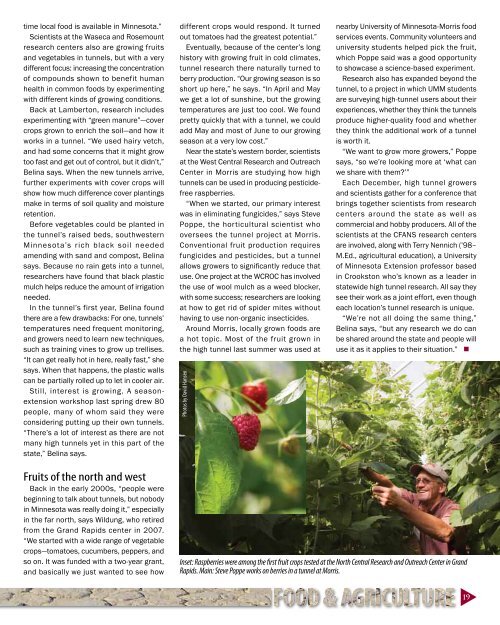PDF Version - College of Food, Agricultural and Natural Resource ...
PDF Version - College of Food, Agricultural and Natural Resource ...
PDF Version - College of Food, Agricultural and Natural Resource ...
You also want an ePaper? Increase the reach of your titles
YUMPU automatically turns print PDFs into web optimized ePapers that Google loves.
time local food is available in Minnesota.”<br />
Scientists at the Waseca <strong>and</strong> Rosemount<br />
research centers also are growing fruits<br />
<strong>and</strong> vegetables in tunnels, but with a very<br />
different focus: increasing the concentration<br />
<strong>of</strong> compounds shown to benefit human<br />
health in common foods by experimenting<br />
with different kinds <strong>of</strong> growing conditions.<br />
Back at Lamberton, research includes<br />
experimenting with “green manure”—cover<br />
crops grown to enrich the soil—<strong>and</strong> how it<br />
works in a tunnel. “We used hairy vetch,<br />
<strong>and</strong> had some concerns that it might grow<br />
too fast <strong>and</strong> get out <strong>of</strong> control, but it didn’t,”<br />
Belina says. When the new tunnels arrive,<br />
further experiments with cover crops will<br />
show how much difference cover plantings<br />
make in terms <strong>of</strong> soil quality <strong>and</strong> moisture<br />
retention.<br />
Before vegetables could be planted in<br />
the tunnel’s raised beds, southwestern<br />
Minnesota’s rich black soil needed<br />
amending with s<strong>and</strong> <strong>and</strong> compost, Belina<br />
says. Because no rain gets into a tunnel,<br />
researchers have found that black plastic<br />
mulch helps reduce the amount <strong>of</strong> irrigation<br />
needed.<br />
In the tunnel’s first year, Belina found<br />
there are a few drawbacks: For one, tunnels’<br />
temperatures need frequent monitoring,<br />
<strong>and</strong> growers need to learn new techniques,<br />
such as training vines to grow up trellises.<br />
“It can get really hot in here, really fast,” she<br />
says. When that happens, the plastic walls<br />
can be partially rolled up to let in cooler air.<br />
Still, interest is growing. A seasonextension<br />
workshop last spring drew 80<br />
people, many <strong>of</strong> whom said they were<br />
considering putting up their own tunnels.<br />
“There’s a lot <strong>of</strong> interest as there are not<br />
many high tunnels yet in this part <strong>of</strong> the<br />
state,” Belina says.<br />
Fruits <strong>of</strong> the north <strong>and</strong> west<br />
Back in the early 2000s, “people were<br />
beginning to talk about tunnels, but nobody<br />
in Minnesota was really doing it,” especially<br />
in the far north, says Wildung, who retired<br />
from the Gr<strong>and</strong> Rapids center in 2007.<br />
“We started with a wide range <strong>of</strong> vegetable<br />
crops—tomatoes, cucumbers, peppers, <strong>and</strong><br />
so on. It was funded with a two-year grant,<br />
<strong>and</strong> basically we just wanted to see how<br />
different crops would respond. It turned<br />
out tomatoes had the greatest potential.”<br />
Eventually, because <strong>of</strong> the center’s long<br />
history with growing fruit in cold climates,<br />
tunnel research there naturally turned to<br />
berry production. “Our growing season is so<br />
short up here,” he says. “In April <strong>and</strong> May<br />
we get a lot <strong>of</strong> sunshine, but the growing<br />
temperatures are just too cool. We found<br />
pretty quickly that with a tunnel, we could<br />
add May <strong>and</strong> most <strong>of</strong> June to our growing<br />
season at a very low cost.”<br />
Near the state’s western border, scientists<br />
at the West Central Research <strong>and</strong> Outreach<br />
Center in Morris are studying how high<br />
tunnels can be used in producing pesticidefree<br />
raspberries.<br />
“When we started, our primary interest<br />
was in eliminating fungicides,” says Steve<br />
Poppe, the horticultural scientist who<br />
oversees the tunnel project at Morris.<br />
Conventional fruit production requires<br />
fungicides <strong>and</strong> pesticides, but a tunnel<br />
allows growers to significantly reduce that<br />
use. One project at the WCROC has involved<br />
the use <strong>of</strong> wool mulch as a weed blocker,<br />
with some success; researchers are looking<br />
at how to get rid <strong>of</strong> spider mites without<br />
having to use non-organic insecticides.<br />
Around Morris, locally grown foods are<br />
a hot topic. Most <strong>of</strong> the fruit grown in<br />
the high tunnel last summer was used at<br />
Photos by David Hansen<br />
nearby University <strong>of</strong> Minnesota-Morris food<br />
services events. Community volunteers <strong>and</strong><br />
university students helped pick the fruit,<br />
which Poppe said was a good opportunity<br />
to showcase a science-based experiment.<br />
Research also has exp<strong>and</strong>ed beyond the<br />
tunnel, to a project in which UMM students<br />
are surveying high-tunnel users about their<br />
experiences, whether they think the tunnels<br />
produce higher-quality food <strong>and</strong> whether<br />
they think the additional work <strong>of</strong> a tunnel<br />
is worth it.<br />
“We want to grow more growers,” Poppe<br />
says, “so we’re looking more at ‘what can<br />
we share with them?’”<br />
Each December, high tunnel growers<br />
<strong>and</strong> scientists gather for a conference that<br />
brings together scientists from research<br />
centers around the state as well as<br />
commercial <strong>and</strong> hobby producers. All <strong>of</strong> the<br />
scientists at the CFANS research centers<br />
are involved, along with Terry Nennich (’98–<br />
M.Ed., agricultural education), a University<br />
<strong>of</strong> Minnesota Extension pr<strong>of</strong>essor based<br />
in Crookston who’s known as a leader in<br />
statewide high tunnel research. All say they<br />
see their work as a joint effort, even though<br />
each location’s tunnel research is unique.<br />
“We’re not all doing the same thing,”<br />
Belina says, “but any research we do can<br />
be shared around the state <strong>and</strong> people will<br />
use it as it applies to their situation.” n<br />
Inset: Raspberries were among the first fruit crops tested at the North Central Research <strong>and</strong> Outreach Center in Gr<strong>and</strong><br />
Rapids. Main: Steve Poppe works on berries in a tunnel at Morris.<br />
19

















